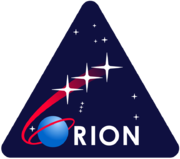Artemis 2
Appearance
| Mission type | Manned Lunar Flyby |
|---|---|
| Operator | NASA |
| Spacecraft properties | |
| Spacecraft type | Orion MPCV |
| Start of mission | |
| Launch date | August 2021[1] |
| Rocket | SLS Block 1B[2] |
| Launch site | Kennedy LC-39B[3] |
| End of mission | |
| Landing site | Pacific Ocean[4] |

Orion Program | |
The Exploration Mission 2 or EM-2 is scheduled to be the first crewed mission of NASA's Orion on the Space Launch System. The mission is to restart manned exploration of the Solar System. NASA is aiming to launch between 2021 and 2023,[5] with a crew to perform a practice flyby of a captured asteroid in lunar orbit.[6] This mission is expected to be the first time Americans will have left low Earth orbit since Apollo 17 in December 1972.
Mission
EM-2 is a single-launch mission of a Space Launch System Block IB with an Exploration Upper Stage, lunar Block 1 Orion Multi-Purpose Crew Vehicle (MPCV), and a payload insertion of 50.7 t. It is to be an 8 day mission with a crew of four astronauts, sent on a free return trajectory around the Moon.[7]
References
- ^ https://www.nasa.gov/feature/nasa-s-first-flight-with-crew-will-mark-important-step-on-journey-to-mars
- ^ Bergin, Chris (February 23, 2012). "Acronyms to Ascent – SLS managers create development milestone roadmap". NASASpaceflight.com. Retrieved July 14, 2012.
- ^ Hill, Bill (March 2012). "Exploration Systems Development Status" (PDF). NASA Advisory Council. Retrieved July 21, 2012.
- ^ Bergin, Chris (June 14, 2012). "NASA teams evaluating ISS-built Exploration Platform roadmap". NASASpaceflight.com. Retrieved July 21, 2012.
- ^ Wall, Mike (September 10, 2015). "NASA's Orion Space Capsule on Course for 2018 Trip Around the Moon". Space.com. Retrieved September 14, 2016.
- ^ Foust, Jeff (March 25, 2015). "NASA Selects Boulder Option for Asteroid Redirect Mission". Space News. Retrieved March 27, 2015.
- ^ https://www.nasa.gov/feature/nasa-s-first-flight-with-crew-will-mark-important-step-on-journey-to-mars
Bibliography
This section is empty. You can help by adding to it. (September 2016) |
External links

